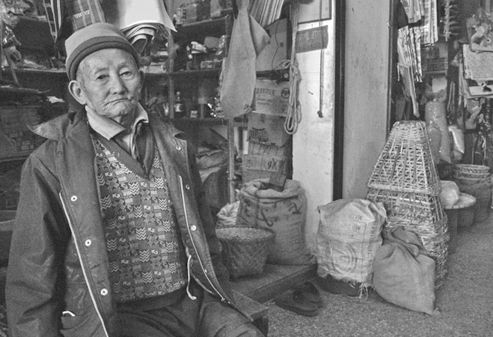At the Cobblers' Row after 14 years
- cdcesikkim
- Apr 5
- 3 min read
Updated: Apr 10

Tshering Eden
Even as malls take over Gangtok, there remain a few places that remind us of simpler times. The cobblers’ row above the Supermarket, near Lall Bazaar in Gangtok is one such place - a place that is reminiscent of a slower, yet richer life.
Fourteen years ago, a story about this cobblers’ row was published in the Face in the Crowd section of Sikkim NOW!. The publication has since folded up, but the cobblers are still there. We wanted to check how things had changed for the people featured in the story and came across some wonderful stories.
We found out that Bangali Ram and Ram Avatar have both retired and returned to their ‘desh.’ Bangali Ram is now 86 and left Sikkim in 2017. His two sons, Jagannath Ram and Dharmender Kumar, work where he used to ply his trade.

Talking to SikkimKo, Dharmender Kumar shares that his father still visits Sikkim, and was last here in 2024.
It was a little surprising to find Bangali Ram’s sons carrying on the trade as many, these days, would not want to follow in their father’s footsteps.
Take 60-year-old Chandeshwar Ram for instance, who does not want his son to become a cobbler. He came to Sikkim with his brother-in-law and started working at the cobblers’ row in Sikkim in 1979. He is among the three cobblers who polish shoes there but he is the only one who exclusively polishes shoes and does not repair them.

As Chandeshwar Ram was sharing his story, a sprightly grey haired man came and waited patiently for us to finish. He is a retired police personnel who has been getting his shoes polished by Chandeshwar Ram for the last 40-45 years.
“I am a retired government employee. I come to town almost everyday because I feel bored at home. Most times I come here to get my shoes polished,” shares 78-year-old CL Bisht. One can picture him as a young policeman getting his boots polished here in the days gone by.
Interestingly, Mr Bisht was a Dogmaster working at the Palace. He used to stay at the Palace to take care of a German Shepherd named Ritchie and train him. His is another story for another day.
“We used to wear shorts, wrap our calves with a ‘patti’, and wear Kanpuri boots on our feet,” he shares.
Mr Bisht says he used to pay Rs 1 for getting his shoes polished in the 70s but now he pays around Rs 50. Even though his shoes did not look like they needed a polish, he still got them shining like new after we finished chatting.

Chandeshwar Ram shares that earnings have significantly gone down over the years and now he hardly gets customers.
“Before we used to get 10-15 customers a day but now we are lucky if we get more than one or two,” he mentions.
He has to attend a relative’s wedding back home but it all hinges on his earnings. “I will go only if I earn enough for the travel,” he adds.
Meanwhile, Ram Avatar’s spot has been taken by his brother Surender who shares that people don’t repair their shoes anymore.
“Even if they do it is mostly to fix some minor wear and tear. Earlier, people would regularly replace or strengthen the soles of their shoes,” he says.

All the cobblers hail from Bihar and come from places like Begusarai, Ara, and Muzaffarpur. On the wall near stall number 4 is a framed photo of the revered poet-saint Ravidas who belonged to the leather-working Chamar community. In the image he can be seen working as a shoe-maker. A contemporary of Kabir, he is closely associated with the Bhakti movement and Sikhism. He is believed to have been a social reformer who was against discrimination based on caste and gender.







Comments